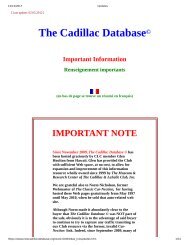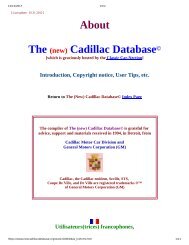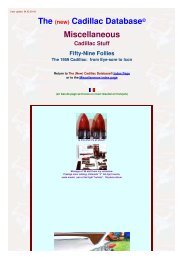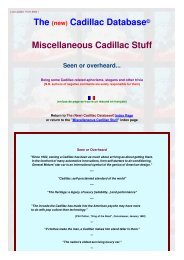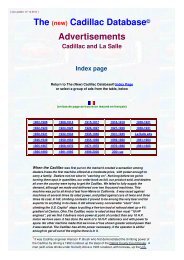FisherCoach
Create successful ePaper yourself
Turn your PDF publications into a flip-book with our unique Google optimized e-Paper software.
[ Last update: 02.24.2014 ]<br />
The (new) Cadillac Database ©<br />
Cadillac and La Salle Insignia<br />
Fisher coach logos and emblems<br />
Fisher Body Craftsman's Guild<br />
Go back to the Cadillac insignia index page<br />
or return to the "Miscellaneous Cadillac Stuff" index page<br />
Return to The (New) Cadillac Database© Index Page<br />
(un résumé en français se trouve en bas de page)<br />
Fisher adopted a Napoleonic coach as its emblem on 10 July 1923, symbolizing the ultimate in hand built<br />
craftsmanship. The design is a combination of two French coaches; one was used at Napoleon's<br />
coronation ceremony, the other at his wedding to Marie Louise of Habsburg-Lorraine, Arch-Duchess of<br />
Austria (1791-1847) 1 . The latter was one in a long train of coaches that had escorted Marie-Louise from<br />
Austria to France for her wedding to Napoleon in 1810. It was used again in 1811 to convey her son, the<br />
new King of Rome (1811-1832), to his christening.<br />
_______________________________________________________<br />
1 Her marriage lasted just 4 years. Marie-Louise left Paris in 1814, became Duchess of Parma in 1815 and wed successively<br />
Count Neipperg and the Count of Bombelles<br />
Historic Napoleonic Coaches<br />
Some typical Napoleonic coach designs of the period<br />
A scale model of Marie-Louise's coach can be seen in House Beautiful, October 1929, p.372 ( below)
Miniature Napoleonic coach drawn by team of six<br />
The Fisher Logo<br />
The Fisher coach logo is featured in many items of factory literature including the 1928 color catalog<br />
Nature's Studios (rear cover). Articles about it have been written in AHR [Automotive History Review] #34,<br />
Spring 1999 [excellent!], Automobile Quarterly [AQ], Vol. 25, #2, 1987, AQ Vol. 29, #4, 1991, Old Cars<br />
Weekly [OCW], 22.8.1991 (p.8), Special Interest Automobiles [SIA] #45, May-June 1978, SIA #61, 2/81,<br />
Cadillac La-Salle Club Self Starter magazine [CLC] 4/96, pp.12-14.<br />
The Fisher logo in its simplest expression<br />
The Fisher coach is featured in many items of factory literature including on the<br />
rear cover of the 1928 color catalog entitled "Nature's Studios" (far right)<br />
Here is a decorative wall plaque<br />
(probably an award of some kind)<br />
This plaque was correctly identified in Feb., 2008, by enthusiast<br />
Steven C. Lang who wrote: this plaque was not an award in the<br />
true sense; it was a plaque given to all the employees at Fisher<br />
Body in Warren Michigan, on the 75th Fisher Body Anniversity<br />
Celebration at the Warren Tech Site, at 12 mile and Van Dyke, in<br />
Warren, MI. I still have mine in a box and I still work at the General<br />
Motors Tech Center in Warren. Even though the 'Days of<br />
Fisherbody' is over, the memory of those day are still alive. Some<br />
people still have the logo posted in their cubes to this day. The<br />
plaques are laser etched (high tech at that time) for the graphics<br />
and very detailed. This weekend I went to a 'Model Train Show'
and a retired Fisher Body/GM employee had a cast belt buckle with<br />
the same coach in detail and quality as that on the above plaque (if<br />
you want a photo of that I could send you one to put with this<br />
grouping of photos). Sure Steven, send it along!<br />
Fisher Body Craftsman's Guild<br />
I saw the Fisher Body Craftsman's Guild mentioned for the first time in a 1930 La Salle product bulletin<br />
entitled "The La Salle Demonstrator". It said: "If there are boys in your home, 12 to 19 years of age<br />
(inclusive) they will be interested in enrolling in the Fisher Body Craftsman's Guild. Details of the Guild's<br />
contest, offering most desirable awards, are available on request at all Cadillac-La Salle dealers".<br />
The Guild was a way for the company to identify and recruit young men with exceptional skill in the<br />
“crafts” needed to design and build bodies for automobiles. Recruitment was by means of magazine ads,<br />
flyers, brochures as well as by teams of recruiters who sometimes visited as many as 1200 high schools<br />
in one season. Each participant had to build a replica of the Napoleonic coach, symbol of Fisher Body,<br />
based on a scale model completed by the Fisher craftsmen themselves.<br />
Blueprints for the first model were non-existent and had to be drawn up. Frank Riess, former head of the<br />
industrial arts department of a Detroit high school, created the master plans (a copy may still be seen in<br />
the Fisher Body Craftsman's Guild Foundation (FBCGF) collection in Eagle Point, OR - in that collection<br />
also are some of the winning coaches as well as other Guild memorabilia).<br />
Walter Leuschner of Germany, a skilled coach-builder in the Fisher plant at Fleetwood, PA, built two<br />
prototype coaches from these plans; these were around 1/15 to 1/18 scale (in which 1 inch = approx. 1' 3"<br />
to 1' 6"); one of the master coach models is featured in a Saturday Evening Post advertisement for April 2,<br />
1932. Some less-elaborate and detailed blueprints and an instruction guide were drawn up for the<br />
competitors. Many of the details were left to interpretation. It was more than just an assembly process. A<br />
great deal of creativity in design and materials was required for a competitive entry. It was not unusual for<br />
a youngster to spend well over a thousand hours on a model.<br />
Basic kits were available to all competitors. They came in a box about 10x10x30 inches. In it were stock<br />
pieces of pine, mahogany and other types of wood. There were also rough aluminum parts needing to be<br />
finished, including the ornate roof railings and "eagle" corner posts. Brass strips were provided and<br />
served to make suspension spring leaves. Wheel spokes and rims had to be made up from scratch.<br />
Included in addition to detailed assembly instructions were swatches of leather and cloth as well as small<br />
bottles of DuPont "Duco" paint, solvents and paint brushes. The finished model measured 18" long (28"<br />
including the tongue), 11" tall and 9" wide; it weighed around 7 pounds. Suspension and steering both<br />
were functional as were the door handles and latches as well as the folding steps for ease of entry and<br />
egress; the doors incorporated sliding glass windows. The cloth and leather samples supplied were used<br />
to upholster the interior, which featured cushioned seats, headliner, door panels and carpeting.<br />
Almost 1,500 boys competed in the first edition; the best of them (104 in all, from 48 states and the District<br />
of Columbia) were convened in the fall of 1931 to a prize-winning ceremony held in the auditorium of the<br />
GM building in Detroit [source: Time magazine, Aug. 31, 1931]. There were two categories: "Junior" (ages<br />
12 to 15) and "Senior" (ages 16 to 19); each entrant hoped to win one of four GM scholarships, each worth<br />
$5,000, in addition to the $50 pocket-money they had got to spend on the trip to Detroit.<br />
The judges who examined the entries and selected the winners were President Thomas Stockham Baker<br />
of the Carnegie Institute of Technology, Board Chairman Robert Andrews Millikan of California Institute of<br />
Technology; Board Chairman Samuel Wesley Stratton of Massachusetts Institute of Technology; Dean<br />
Dexter Simpson Kimball of Cornell's College of Engineering and eight other engineering deans and<br />
professors.<br />
The "Senior" winners were Raymond S. Doerr of Battle Creek, and Albert Fischer from Waukegan Ill. One<br />
"Junior" winner was Howard Jennings of Denver, CO. Over the years the competition lasted, some<br />
245,000 American boys between the ages of 12 and 19 participated. Many of the winners later were
offered and managed successful careers at Fisher Body and GM.<br />
Left: this artist's view of the boys' competition was used in a Cadillac magazine ad published, inter<br />
alia, in the Saturday Evening Post for April 2, 1932. Right: one of the winners was Roger Oetting<br />
Two winning entries (Chester Geist, left, and a Mr. Masche, right)<br />
[ photos of more winning entries, below ]<br />
Official emblem of the Fisher Body Craftsman's Guild<br />
[ competitors all wore a cap with this "badge" ]<br />
Fisher Body Craftsman's Guild certificate
At the time of the competition and far into the sixties, the Fisher coach was<br />
frequently<br />
seen in Cadillac and GM advertising. Left: the Dionne quintuplets from<br />
Canada<br />
look admiringly at a completed model. Right, a 1960 GM ad<br />
Detail from another GM-Fisher ad from 1960<br />
Fisher Body Craftsman's Guild Foundation<br />
Nobody knows more about the Guild and the competition, nor has accumulated more of the surviving<br />
competition coaches than Skip Geear, who has devoted a small, private museum to this fascinating part<br />
of the history of GM and the Fisher Body Corporation. The museum is located on Skip's 20-acre spread, 9<br />
miles north of Eagle Point, OR, 18 miles north of Medford, OR and some 40 miles north of the California<br />
border [had we known about it at the time, Gita and I certainly would have visited the museum, which is<br />
only a few miles off the route we followed through Oregon in the fall of 2006].<br />
Among the museum holdings is one of the two prototype coaches built in the late 20s by Walter<br />
Leuschner; there are also the original set of plans drawn by Frank Riess, as well as more than two dozen<br />
surviving competition coaches. Skip's prized possession, however, is a full-scale Napoleonic coach<br />
commissioned by Fisher from the late Francis Londo who had been one of the Guild competitors in 1934.<br />
It was completed only in 1991. Londo willed it to Skip before he died.<br />
The Londo full-sized coach weighs one<br />
and a half tons;<br />
it measures 16 feet long and is 9 feet high
The model on the left was up for auction at Scottsdale, AZ, in January 1999<br />
The coach on the right is a family heirloom; it was built by the grandfather of Kendra Kroll,<br />
a Database visitor in July 2001, whom I should like to credit with this photo.<br />
Here is another "competition" coach; look at all that incredible detail!<br />
This prize-winning model<br />
was constructed by the late Harold Wilkin<br />
This is the 1934 National Senior winner;<br />
it was built by Truman W. Cottom of Texas<br />
Here are two more prize-winners
Left: 1932 competition winner, Roger Oetting; note the competition cap with the "FBCG" patch<br />
Right: the young Guild competitor at far right, with Oetting, is none other than Virgil Exner, then aged 11;<br />
he went on to become the driving force behind Chrysler styling<br />
Guild History<br />
Interestingly, the Guild continued in existence well into the sixties (the last year for the competition being<br />
1968) and continued also to encourage American boys to build automotive scale models. In 1960, in a<br />
booklet entitled The Story of Body by Fisher, a couple of pages are devoted to the Guild. By that time it<br />
had awarded 238 university scholarships totaling over $640,000 and paid out more than one million<br />
dollars in prizes (the total purse in 1960 alone was $117,000). From 1930-1960, the Guild enrolled more<br />
than five million boys of which a half-million in 1960 alone.<br />
(Left) Judges in the Fisher Body Craftsman's Guild examine submissions for the 1960 edition of the competition<br />
(Right) A selection of the individual models that were entered in the competition (no obvious Cadillac dream cars here)<br />
[ Photo: © 1960 GM/Fisher - The Story of Body by Fisher ]
The Silver and Gold Commemorative Coach<br />
In 1972-73 Fisher issued a Golden Anniversary portfolio. In it was offered to all GM dealers a silver and<br />
gold commemorative scale model of the Fisher coach. The cost was $2,000 a piece. Only 1000 units were<br />
to be built, hallmarked and inscribed with the owner's personal registration number. The item was<br />
described as "what promises to be one of the most sought after collector items ever produced in a<br />
precious metal." To my knowledge, there is no official record of how many were effectively built nor who<br />
bought them. In the last 30+ years I only ever saw one offered for sale ...at a price!<br />
Fisher Golden Anniversary<br />
commemorative silver and gold scale model<br />
[ as illustrated in the flyer ]<br />
The (final?) Guild Reunion, June 2004<br />
As Vice-President of Design, retired, Chuck instigated a meeting in late June, 2004 of winners of the Guild<br />
contest. It was staged in the massive Design Dome at the General Motors Tech Center in Warren,
Michigan. Some 60 winners attended. The oldest winner was Henry Larzelere, he built a coach for the 1936<br />
edition; the youngest was Tom Graboski who won the Styling Award at age 13 in 1968, the final year. On<br />
display in the "Dome", were all their winning entries. An awesome sight. Next day, a fund raising event for<br />
the blind was held in a large marquee, where the models were once again on display. Among the entrant's<br />
was Virgil Exner Jr. He was interviewed on that occasion by twice-President of the CLC, Ron Van<br />
Gelderen. You can read the interview in the Self Starter for June, 2005. The reunion lasted through<br />
Monday when the group visited the brand new GM Heritage Center, a few miles north of the Tech Center,<br />
where GM's car collection and extensive archives now are housed under one large roof.<br />
Misc. Guild Stuff<br />
I have seen a booklet published by the Guild in the sixties (?) entitled Design & Build a Model Car. It was<br />
provided to college engineering and design students as an aid to creating a professional model of a<br />
futuristic car, a part of competing for a Guild scholarship. The brochure It measures 8½ x 5" and<br />
comprises 35 pages, with many illustrations and tips. My old friend Charles "Chuck" Jordan, who was to<br />
become GM Design Chief entered and won such a competition in the fifties.<br />
For more reading about the Guild, visit this Web page on the site created by Richard Earl, grandson of<br />
Harley J. Earl: http://www.carofthecentury.com. The most interesting "Fisher Coach" site on the Web is<br />
this one: http://www.geocities.com/sponcom26/CoachMuseum1.html<br />
In researching the history of the Fisher Body Craftsman's Guild, I came across a Web site on the Internet,<br />
devoted to scale-modeling in general. Interestingly, on the site's message board, there were a number of<br />
postings that relate to the Fisher Coach competition of the mid-thirties. Here are some of the entries:<br />
Carolyn Cottom wrote: My father, Truman Cottom, entered the competition twice. He won 4th<br />
place in 1933 and 1st place in 1934. I don't know if this was state or national. He lived in Texas<br />
at the time and won a four-year college scholarship in 1934.<br />
George Lake wrote: My half brother Milton Lake built a coach for the contest. It has been<br />
carefully preserved and is in possession of his widow in Manitoba Canada<br />
Linda Barrett wrote: I have the complete original plans, in excellent condition. Also have the<br />
coach that my father made for the 1932 competition, along with some associated newspaper<br />
articles, and the wooden shipping box that was constructed according to the original plans.<br />
Lina Nilan wrote: My Father in law has a coach he was building in high school for a scholarship<br />
A. Rasmussen wrote: My Father (Harold E. Rasmussen 1919-1991 of Milestone Saskatchewan<br />
Canada) won a scholarship at M.I T. We (my sister brother and myself believe). A ribbon in the<br />
coach's glass case says 'JUNIOR FIRST GRAND AWARD 1934 - CANADIAN SECTION'.<br />
Finally, here's a book from 2005 by John L. Jacobus that presents the Guild from inception, through<br />
expansion and up to the end, in 1968. Many aspects of the Napoleonic coach model are covered in these
336 pp. (ISBN 0-7864-1719-6 and ISBN 9789-0-7864-1719-3) - ad in SAH Journal, issue #230, Sept.-Oct.<br />
2007, p.9<br />
Fake ?<br />
Described as a "Fisher" competition coach model<br />
this finely carved artifact was offered for sale on e-Bay, in 2000<br />
It is NOT, however, one of the Fisher competition coaches<br />
( résumé en français)<br />
Fisher, carrossier attitré de la firme, prit pour emblème, le 10 juillet 1923, ce<br />
superbe carrosse napoléonien pour symboliser son travail artisanal soigné.<br />
Il s'agit d'un assemblage de deux carrosses différents; le premier fut utilisé à<br />
l'occasion du couronnement de Napoléon, l'autre pour son mariage en 1810 avec<br />
Marie-Louise de Habsbourg-Lorraine, archi-duchesse d'Autriche. Ce carrosse<br />
reprit du service à l'occasion du baptême de son fils, le roi de Rome.<br />
En 1931, la firme Fisher lança un concours pour jeunes américains âgés de 12 à<br />
19 ans. Il y eut 245,000 participants. Le but en était d'encourager la jeunesse à se<br />
vouer à l'artisanat. Il leur fallait reproduire le plus fidèlement possible une<br />
maquette du carrosse qui avait été préparée à cet effet par la firme elle-même. Les<br />
plans en avaient été dessinés par Frank Riess, enseignant dans une éclole<br />
technique de Detroit. Deux maquettes furent réalisées d'après ces plans par<br />
Walter Leuschner, maître-artisan d'origine allemande. Le quatre premiers lauréats<br />
se virent offrir des bourses d'étude d'une valeur de $5000; une jolie somme en<br />
1931!
La maquette d'origine réalisée par Fisher figure sur une publicité de la firme parue<br />
dans "Saturday Evening Post" le 2 avril 1932.<br />
En 1973, pour commémorer son cinquantenaire, la firme mit en vente 1000<br />
modèles réduits à l'échelle 1/18e, en argent et or, au prix de $2000 pièce. Ces<br />
maquettes étaient destinées aux distributeurs Cadillac dans tout le pays.<br />
Go back to the Cadillac insignia index page<br />
or return to the "Miscellaneous Cadillac Stuff" index page<br />
Return to The (New) Cadillac Database© Index Page<br />
© 1996, Yann Saunders and the Cadillac-LaSalle Club, Inc.<br />
[ Background image: superimposed Cadillac and La Salle emblems, 1929 ]






